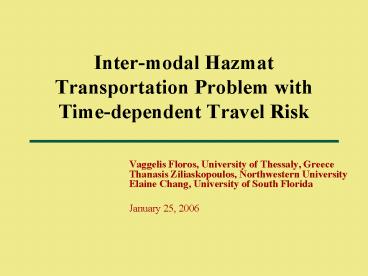Intermodal Hazmat Transportation Problem with Timedependent Travel Risk
1 / 22
Title:
Intermodal Hazmat Transportation Problem with Timedependent Travel Risk
Description:
Inter-modal Hazmat Transportation Problem with Time-dependent Travel Risk ... Departure Trip. Time Cost. 1 35.8. 2 26.2. 3 26.7. 20. Summary ... –
Number of Views:23
Avg rating:3.0/5.0
Title: Intermodal Hazmat Transportation Problem with Timedependent Travel Risk
1
Inter-modal Hazmat Transportation Problem with
Time-dependent Travel Risk
- Vaggelis Floros, University of Thessaly, Greece
- Thanasis Ziliaskopoulos, Northwestern University
- Elaine Chang, University of South Florida
- January 25, 2006
2
Introduction
- The problem of computing minimum cost routes is
considered in a transportation network with
transshipment stations and a variety of
alternative modes - Risk is incorporated into the cost function
without affecting the quality and speed of the
computation - The parameters of the transportation network are
time-dependent, resulting in more realistic
network representation - Possible transfer delays, risks and costs between
transport modes are easily accounted for
3
Background
- List, Mirchandani, Turnquist and Zografos (1991)
- Sivakumar, Batta and Karwap (1995)
- McCord and Leu (1995)
- Brainard, Lovett and Parfitt (1996)
- Frank, Thill and Batta (2000)
- Zografos and Androutspoulos (2004)
- Huang and Fery (2005 TRB CD-ROM)
4
Problem Formulation
- A hazmat shipment is to be carried along an
optimal path between origin and destination by
combining the available modes, while accounting
for travel times, costs and risks
arc travel cost
arc travel time
arc risk
transfer cost
transfer time
transfer risk
5
Solution Algorithm
- Label-correcting approach
- Time-varying
- Maintain both cost and time labels, accounting
for risk - Account for transfer costs, time and risk
6
Solution Algorithm
- Step 1 Initialize labels ?ijm(t), ? ijm(t) ?,
?iDm(t), ? iDm(t) 0 - Insert the destination node D into the Scan
Eligible (SE) list. - Step 2 While SE list not empty, delete the first
node k from the list - For every link-mode hjk m2?? -1(k)
- For every link-mode hij m1?? -1(j)
- For all time intervals t?T
- If ? ijm(t) gt ? ijkm1m2(t)?jkm2(t?ij
km1m2(t)) - ?jkm2(t?ijkm1m2(t
) ?jkm2(t?ijkm1m2(t))) - Then update ? ijm(t) , ? ijm(t) and
insert node j into the SE list. - Step 3 Terminate.
7
CheckCost / Risk Label
some route to D
??jkm2
k
D
j
??ijm1
?
i
?ijm1(t)gt ? ijkm1m2(t)
?jkm2(t?ijkm1m2(t)) ?jkm2(t?ijkm1m2(t)
?jkm2(t?ijkm1m2(t)))
8
UpdateCost / Risk Label
some route to D
??jkm2, ?jkm2
k
D
j
? ijm1, ?ijm1
?ijm1(t) ? ijkm1m2(t)
?jkm2(t?ijkm1m2(t)) ?jkm2(t?ijkm1m2(t)
?jkm2(t?ijkm1m2(t)))
i
?ijm1(t) ?ijkm1m2(t) ?jkm2(t?ijkm1m2(t
)) ?jkm2(t?ijkm1m2(t)
?jkm2(t?ijkm1m2(t)))
9
UpdateSuccessor Label
some route to D
k
D
j
successorijm1(t) k, m2
successor to j on least cost path from j to D,
when arriving at j at time t from i and m1
i
10
TDIMCP Convergence
- Algorithm terminates in a finite number of
iterations - O( T2X2NH ) - At termination every cost label ?ijm(t) is either
- An infinite number no path exists, or
- A finite number cost of least-cost path
11
Computational Complexity
- Linear with N, as expected
12
Computational Complexity
- Almost linear with T (ltT2)
13
Test Network
14
Test Network
15
Scenario 0 Base
16
Scenario 1 Link Closure
X
17
Scenario 2 Reduced Rail 3-4
X
18
Scenario 3 High Risk Facility
19
Scenario 4 Time-Varying Risk
20
Summary
- An algorithm for computing intermodal routes is
for hazmat shipments was presented, accounting
for transfer delays, risks and costs between
transport modes were considered - Risk was incorporated into the cost function
without affecting the quality and speed of the
computation - The parameters of the transportation network are
time-dependent, resulting in more realistic
network representation - Computational tests show reasonable computation
time and scenario results - Future research Hazmat scenarios may be tested
in a dynamic traffic assignment environment to
capture realistic traffic congestion
21
Acknowledgements
- This work was partially funded by the European
Unions INTERREG IIIc Project RESCUE A
Catastrophe Response and Recovery Logistics and
Transport Decision Support System
22
Questions?
- Elaine Chang
- Phone 813-974-1738
- Email echang_at_eng.usf.edu































